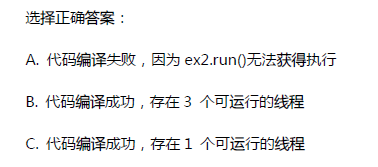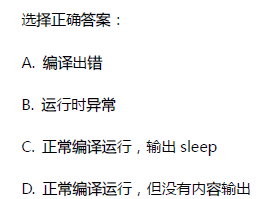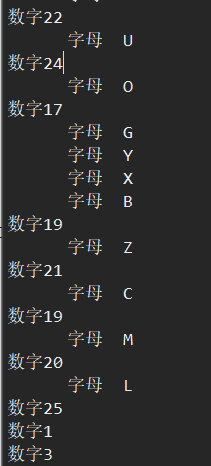在千锋逆战学习Java的第28天
加油!
今天学习了多线程的概念,创建方式,sleep()、yield()、join()方法和同步方式。
作业题:
1.一个单CPU的机器,如何同时执行多个线程?请简述其原理
宏观串行,微观并行。cpu会分配给不同的进程时间片,一个进程时间片结束执行下一个,多个进程穿插执行
2.有如下代码
public class Example implements Runnable{
public void run(){
while(true){
}
}
public static void main(String[] args) {
Example ex1 = new Example();
Example ex2 = new Example();
Example ex3 = new Example();
ex1.run();
ex2.run();
ex3.run();
}
}

答:C
3.有以下代码
class Example implements Runnable{
public static void main(String[] args) {
Thread t = new Thread(new Example());
t.start();
}
public void run(int limit){
for(int x =0; x<limit;x++){
System.out.println(x);
}
}
}

答:C
4.有以下代码
class Example {
public static void main(String[] args) {
Thread.sleep(3000);
System.out.println("sleep");
}
}

答:A
5.

代码:
import java.util.Random;
public class TestPrint {
public static void main(String[] args) {
Number n = new Number();
Thread l = new Thread(new Letter());
n.start();
l.start();
}
}
//输出100个1~26
class Number extends Thread{
public void run(){
for(int i = 1; i<=100; i++){
Random r = new Random();
int a =r.nextInt(26)+1;
System.out.println("数字"+a);
}
}
}
//输出100个A~Z
class Letter implements Runnable{
public void run() {
for(int i = 1; i<=100; i++){
// Random r = new Random();
// int a = r.nextInt(26)+65;
// char c = (char)a;
char c = (char) ( new Random().nextInt(26)+65 );
System.out.println(" 字母 "+c);
}
}
}
运行结果

6.
public class TestMyThread {
public static void main(String[] args) {
Object lock = new Object();
Thread t1 = new MyThread1(lock);
Thread t2 = new MyThread2(lock);
t1.start();
t2.start();
}
}
class MyThread1 extends Thread {
Object lock;
public MyThread1(Object lock) {
this.lock = lock;
}
public void run() {
synchronized (lock) {// 1
for (int i = 0; i <= 10; i++) {
try {
Thread.sleep((int) (Math.random() * 1000));
} catch (Exception e) {
}
System.out.println("$$$");
}
}
}
}
class MyThread2 extends Thread {
Object lock;
public MyThread2(Object lock) {
this.lock = lock;
}
public void run() {
synchronized (lock) {// 2
for (int i = 0; i <= 10; i++) {
try {
Thread.sleep((int) (Math.random() * 1000));
} catch (Exception e) {
}
System.out.println("###");
}
}
}
}
问:在//1和//2处加上的synchronized起什么作用?如果不加synchronized,运行程序有什么不同的地方
对临界资源对象加锁,保证每一个进程的原子操作不被破坏;
如果不加的话,会出现两个程序并发访问临界资源,导致原子结构被破坏有可能出现数据异常
7.
public class TestMyThread {
public static void main(String[] args) {
Thread t1 = new MyThread("hello");
Thread t2 = new MyThread("world");
t1.start();
t2.start();
}
}
class MyThread extends Thread{
private String data;
public MyThread(String data) {
super();
this.data = data;
}
public void run(){
synchronized (data) {
for(int i=0; i<10 ;i++){
try {
Thread.sleep((int) (Math.random()*1000));
} catch (Exception e) {
}
System.out.println(data);
}
}
}
}

选C
